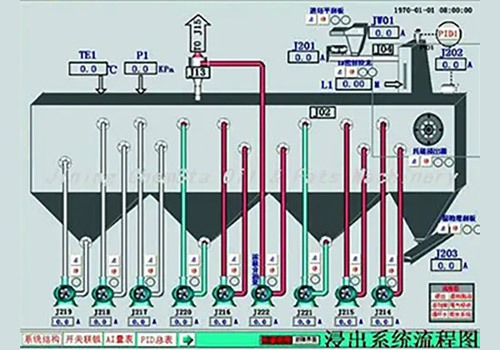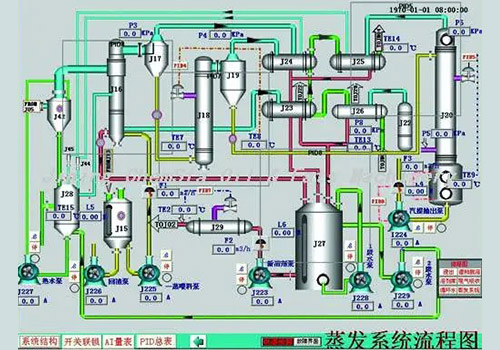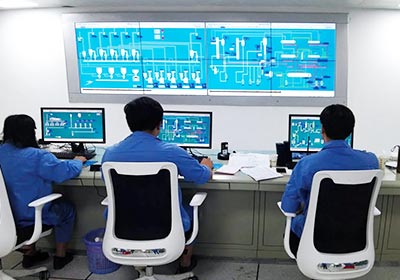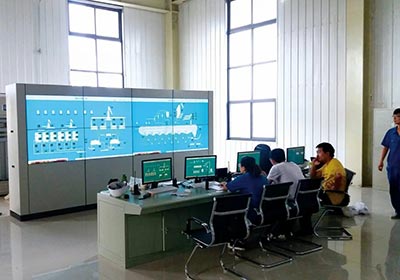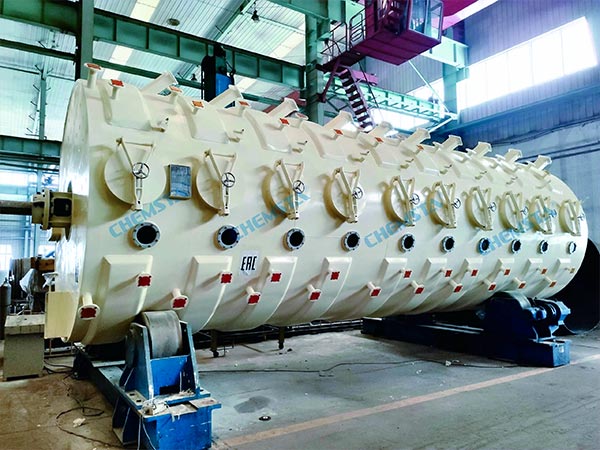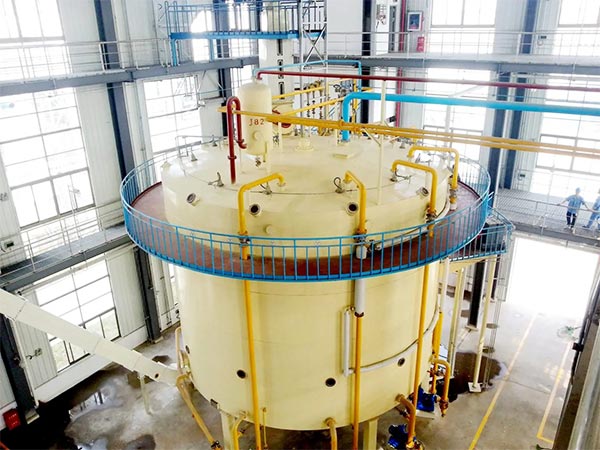Soybean White Flake
Soybean White Flake (Low Temperature Soybean Meal) Production Line
Soybean meal has high requirements for fat content, powder fineness, color and NSI value because it is extensively used as a raw material for production of SPC, SPI, histone and wiredrawing protein. CHEMSTA provides various soybean intensive processing lines, one of which is suitable for production of low temperature soybean meal.
Briefly Introduction
1. Raw Materials: soybeans
2. Products: low temperature soybean meal (Soybean white flake)(NSI ≥ 85%), soybean oil
3. Applications: Low temperature soybean meal (white flake) is widely used in the production of soybean proteins such as SPI, SPC (protein content: higher than 50 percent, fat content: 0.5 percent)
4. Production Process: Cleaning, classifying, peeling, low-temperature treating, degreasing, lower-temperature desolventizing and low-temperature vacuum drying
5. Workshops (Production Sections): Soybean warehouse, cleaning and classifying workshop, low-temperature dehulling workshop, solvent extraction and low-temperature desolventizing workshop, packing workshop and auxiliary workshops.
2. Products: low temperature soybean meal (Soybean white flake)(NSI ≥ 85%), soybean oil
3. Applications: Low temperature soybean meal (white flake) is widely used in the production of soybean proteins such as SPI, SPC (protein content: higher than 50 percent, fat content: 0.5 percent)
4. Production Process: Cleaning, classifying, peeling, low-temperature treating, degreasing, lower-temperature desolventizing and low-temperature vacuum drying
5. Workshops (Production Sections): Soybean warehouse, cleaning and classifying workshop, low-temperature dehulling workshop, solvent extraction and low-temperature desolventizing workshop, packing workshop and auxiliary workshops.
Pretreatment
1. Soybean Warehouse:
Major Devices: soybean unloading machine, preliminary cleaner, steel silo, elevator, conveyor, electrical control equipment, and other auxiliary devices.
Features: Full-mechanized operation is accomplished during soybean transportation process, which significantly reduces production costs. To improve soybean purity, CHEMSTA will remove large-grained impurities and dust from soybeans before putting them into relevant silos. The warehouse is equipped with machines, which are designed to automatically put soybeans into silos, take soybeans out of silos and change soybean silos.
Features: Full-mechanized operation is accomplished during soybean transportation process, which significantly reduces production costs. To improve soybean purity, CHEMSTA will remove large-grained impurities and dust from soybeans before putting them into relevant silos. The warehouse is equipped with machines, which are designed to automatically put soybeans into silos, take soybeans out of silos and change soybean silos.
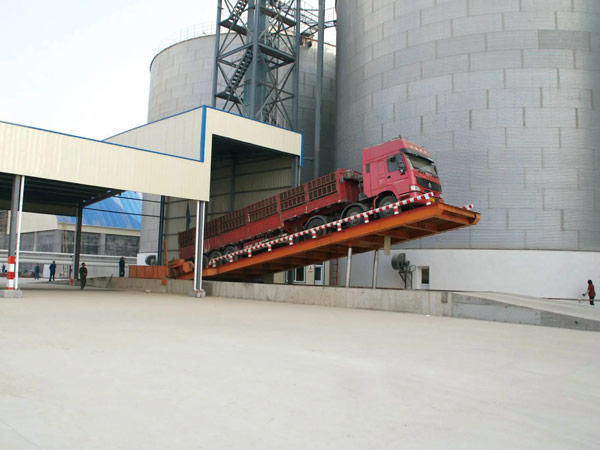
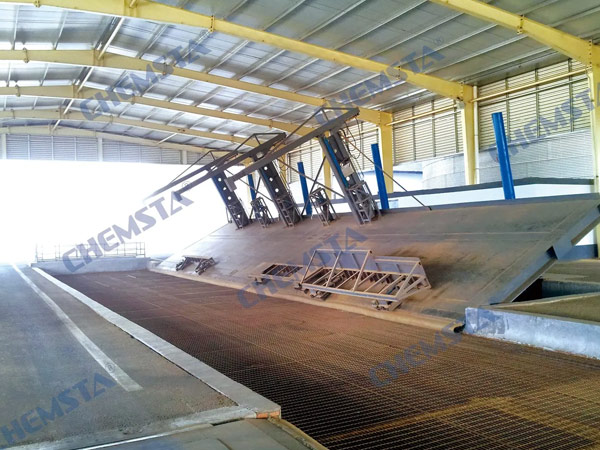
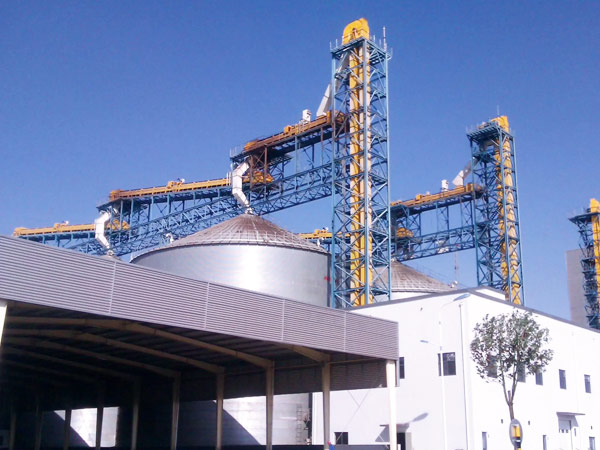
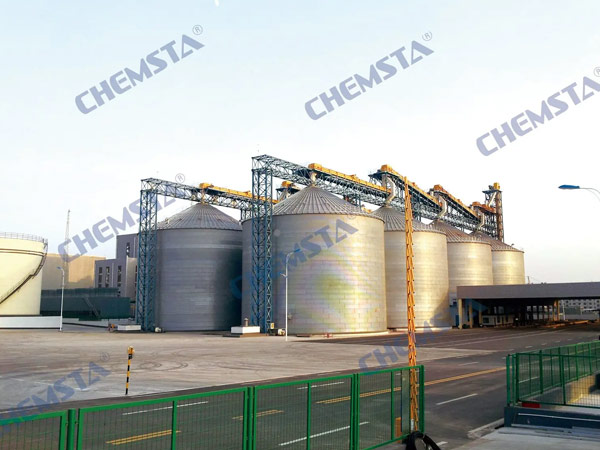
2. Cleaning and Classifying Workshop:
Major Devices: rotary flat cleaning sieve, stoning machine, flat classifying screen, magnetic separator, online scale, dust removal equipment, rising conveyor, electrical control equipment and other auxiliary devices.
Features: Cleaning sieve, stoning machine and magnetic separator are respectively used to remove organic impurities, stones, and iron particles out of soybeans, which ensures superior product quality and prevents all these impurities from damaging relevant mechanical equipment. Classifying screen is able to sort soybeans into different grades by size, thus further ensuring high quality of finished low temperature soybean meal. Online scale accurately measures the weight of soybeans, which contributes to stable production and easy management. For clean production environment, dust removal equipment is equipped as well.
Features: Cleaning sieve, stoning machine and magnetic separator are respectively used to remove organic impurities, stones, and iron particles out of soybeans, which ensures superior product quality and prevents all these impurities from damaging relevant mechanical equipment. Classifying screen is able to sort soybeans into different grades by size, thus further ensuring high quality of finished low temperature soybean meal. Online scale accurately measures the weight of soybeans, which contributes to stable production and easy management. For clean production environment, dust removal equipment is equipped as well.
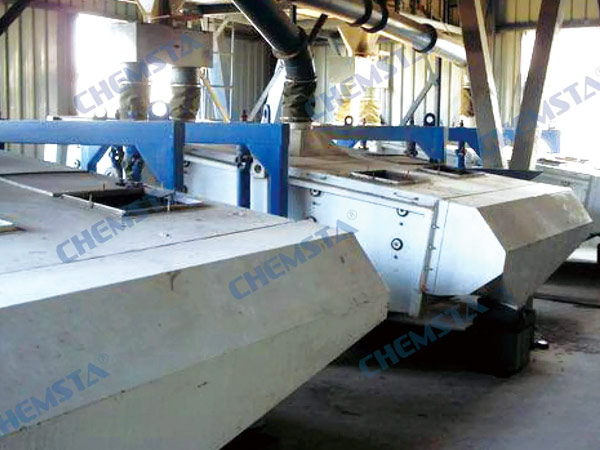
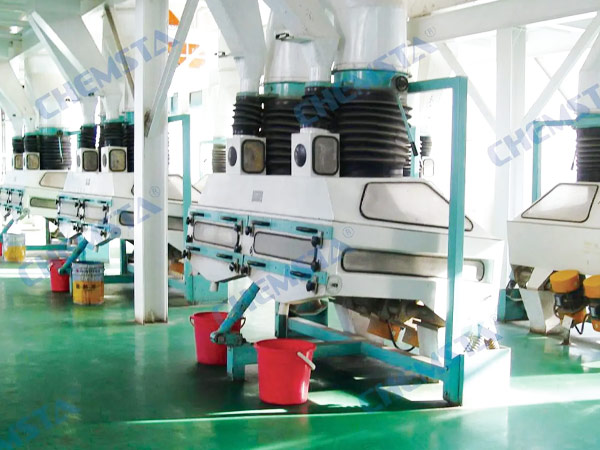
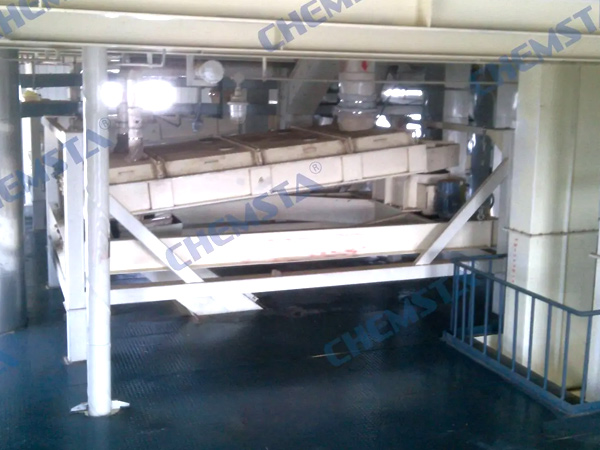
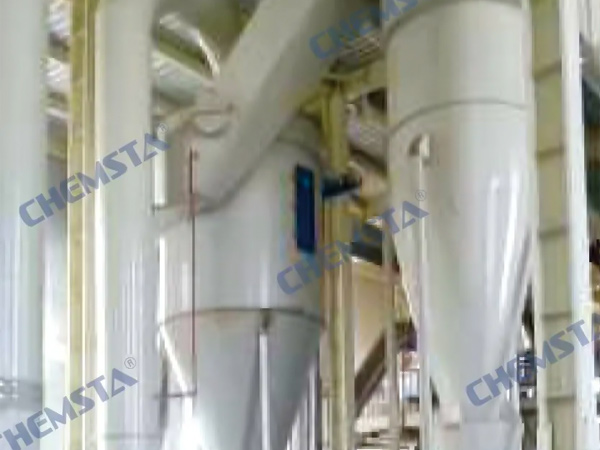
3. Low temperature dehulling workshop:
Major Devices: conditioning & drying tower, peeling machine, husk and kernel separator, kernel softening cooker, flaking mill, magnetic separator, dust removal equipment, rising conveyor, electrical control equipment and other auxiliary devices
Features:
Soybean softening and drying are both conducted at a lower temperature, which reduces steam consumption and causes less NSI(water-soluble protein) loss. Dehulling machine, along with husk and kernel separator(Aspirator), is able to completely and evenly remove soybean hulls, which facilitates softening and flaking. The soybean flakes obtained feature uniform thickness and high tenacity, thus ensuring superior quality of finished low temperature soybean meal. Waste heat generated during the production process will be fully recycled for energy conservation. A PLC automatic control system is adopted to control critical parameters such as stock level, temperature, pressure, and flow rate.
The graded soybeans are first weighed so as to calculate the yield, then enter the buffer tank and the dampening auger(for wetting soybeans). Water is added to the dampening auger, and then the soybeans and water are mixed to make the water evenly spread on the surface of the soybeans and then the soybeans enter the wetting tank. After holding for a certain period of time, the surface moisture of the soybeans fully enters the soybean hulls without entering the beans, and the soybean epidermis is crumpled; then the soybeans enter the drying tower to dry the moisture of the soybean epidermis, and simultaneously adjust the moisture. After drying, the crumpled soybean epidermis cracks, and then the soybeans enter the crusher. The crushed soybeans first pass through the aspirator to separate the soybean hulls, and then go through the grading sieve for another hull separation. The crushed beans then enter the softening process.
The crushed beans enter the softening cooker through the air lock, and are softened for a long time at a low temperature. By using hot water for heating, it is easier to control the softening temperature of soybeans and reduce the loss of NSI. The discharge door of this softening cooker is a self-control one, which is based on our mature technology. The crushed beans gradually descend from the upper layer to the lower layer to avoid some of the soybeans not being softened well when the equipment starts up. The softened soybeans enter the aspirator again to separate the hulls and kernels, and fully remove the bean hulls in the crushed beans. The aspirator uses the air from the drying tower to ensure the temperature of the crushed beans before flaking, and then the softened soybeans enter the flaker. The soybean white flakes are then delivered by a scraper to the extracting section.
Features:
Soybean softening and drying are both conducted at a lower temperature, which reduces steam consumption and causes less NSI(water-soluble protein) loss. Dehulling machine, along with husk and kernel separator(Aspirator), is able to completely and evenly remove soybean hulls, which facilitates softening and flaking. The soybean flakes obtained feature uniform thickness and high tenacity, thus ensuring superior quality of finished low temperature soybean meal. Waste heat generated during the production process will be fully recycled for energy conservation. A PLC automatic control system is adopted to control critical parameters such as stock level, temperature, pressure, and flow rate.
The graded soybeans are first weighed so as to calculate the yield, then enter the buffer tank and the dampening auger(for wetting soybeans). Water is added to the dampening auger, and then the soybeans and water are mixed to make the water evenly spread on the surface of the soybeans and then the soybeans enter the wetting tank. After holding for a certain period of time, the surface moisture of the soybeans fully enters the soybean hulls without entering the beans, and the soybean epidermis is crumpled; then the soybeans enter the drying tower to dry the moisture of the soybean epidermis, and simultaneously adjust the moisture. After drying, the crumpled soybean epidermis cracks, and then the soybeans enter the crusher. The crushed soybeans first pass through the aspirator to separate the soybean hulls, and then go through the grading sieve for another hull separation. The crushed beans then enter the softening process.
The crushed beans enter the softening cooker through the air lock, and are softened for a long time at a low temperature. By using hot water for heating, it is easier to control the softening temperature of soybeans and reduce the loss of NSI. The discharge door of this softening cooker is a self-control one, which is based on our mature technology. The crushed beans gradually descend from the upper layer to the lower layer to avoid some of the soybeans not being softened well when the equipment starts up. The softened soybeans enter the aspirator again to separate the hulls and kernels, and fully remove the bean hulls in the crushed beans. The aspirator uses the air from the drying tower to ensure the temperature of the crushed beans before flaking, and then the softened soybeans enter the flaker. The soybean white flakes are then delivered by a scraper to the extracting section.
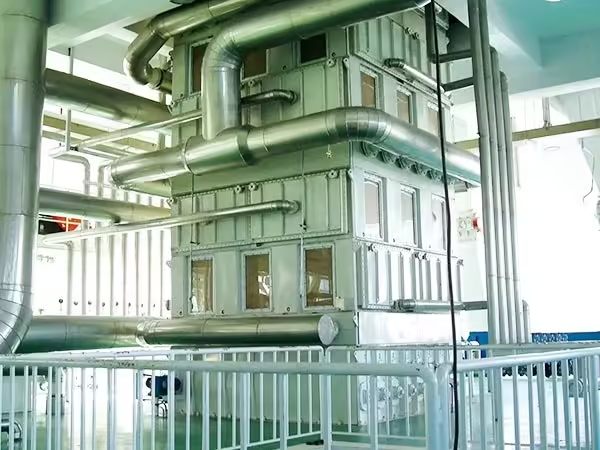
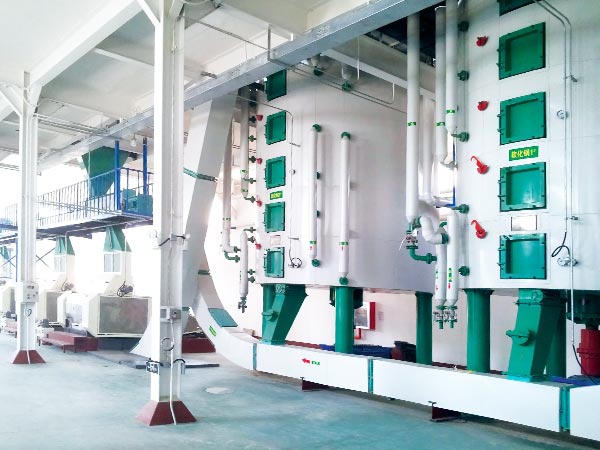
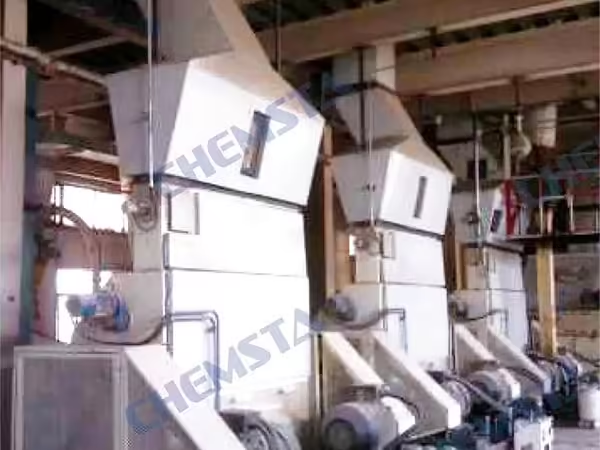
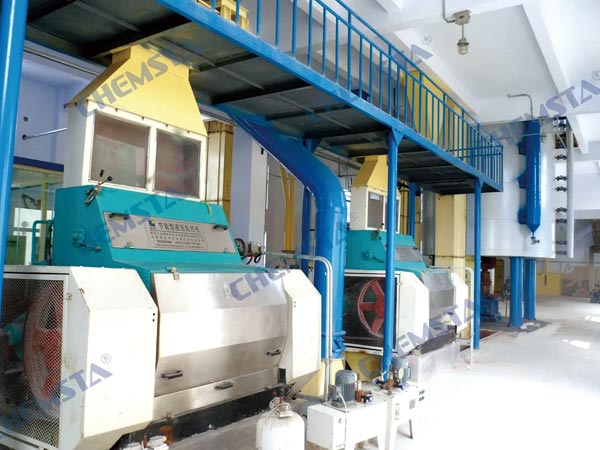
Solvent Extraction Workshop
1. Oil Extraction:
Customers can choose rotocel extractor or drag chain extractor based on their requirements. For different raw materials, the grid tray clearance and grid tray arrangement will be properly adjusted to ensure that the oil residues in the seed meal are at a minimum. In addition, liquids in the seed meal will be completely drained, contributing to a minimum solvent content. As a result, the burden on the desolventizing device in the sequential process is significantly lowered, reducing the steam consumption.
Soybean flakes (raw material) are transported from the feeding scraper to the level control box of extractor, and enter the extractor from the air lock. After solvent spraying, soaking, extracting and draining, the material is then sprayed with fresh solvent (solvent and material flow in reverse). Finally, the extracted meal is drained and dropped into the wet meal scraper conveyor, then conveyed to the low temperature desolventizing system(Tank A/B) respectively according to the production needs. The dense miscella firstly removes the impurity by hydrocyclone, then enters automatic slag filter to remove impurity and then enters the first evaporation system.
Solvent extractor is the extraction equipment designed by CHEMSTA for soybean white flakes(low temperature soybean meal) and is our patented product.
Solvent extractor is the extraction equipment designed by CHEMSTA for soybean white flakes(low temperature soybean meal) and is our patented product.
Soybean flakes (raw material) are transported from the feeding scraper to the level control box of extractor, and enter the extractor from the air lock. After solvent spraying, soaking, extracting and draining, the material is then sprayed with fresh solvent (solvent and material flow in reverse). Finally, the extracted meal is drained and dropped into the wet meal scraper conveyor, then conveyed to the low temperature desolventizing system(Tank A/B) respectively according to the production needs. The dense miscella firstly removes the impurity by hydrocyclone, then enters automatic slag filter to remove impurity and then enters the first evaporation system.
Solvent extractor is the extraction equipment designed by CHEMSTA for soybean white flakes(low temperature soybean meal) and is our patented product.
Solvent extractor is the extraction equipment designed by CHEMSTA for soybean white flakes(low temperature soybean meal) and is our patented product.
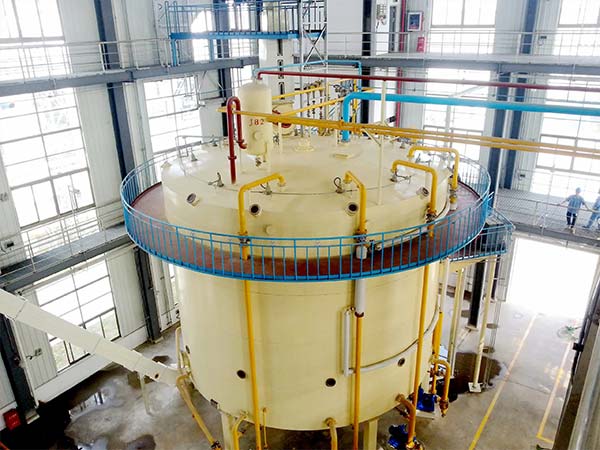
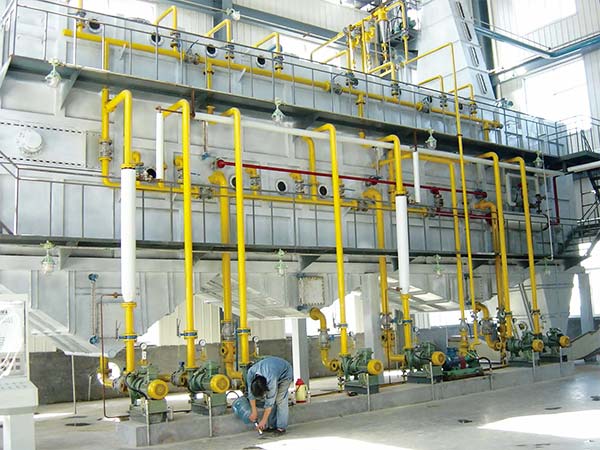
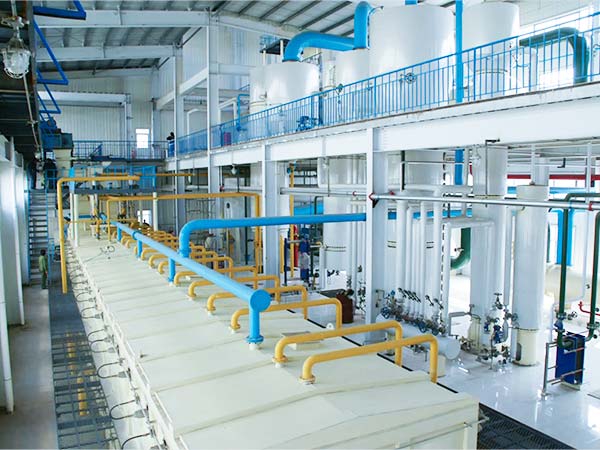
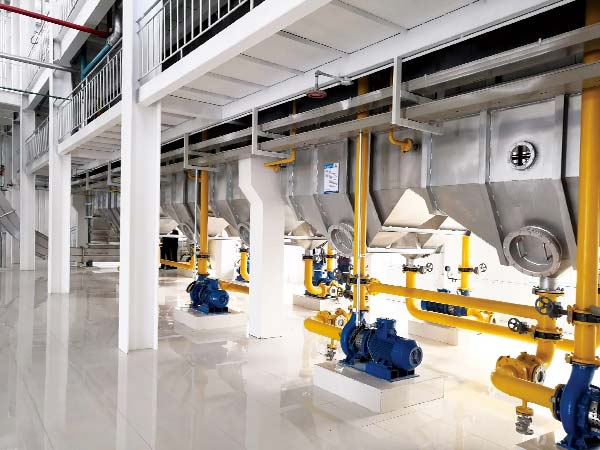
2. Low Temperature Desolventizing:
Wet meal are conveyed to low temperature desolventizing system through wet meal scraper, closed valve; wet meal are removed solvent under the circulation of hot solvent gas.
CHEMSTA low temperature desolventizer (Tank A/B) is the key equipment to ensure the quality of low temp soybean meal.Optimized design of new spiral, stirring plate and process shaft fully eliminates the impact of thermal expansion factor on machinery and product. It can also gurantee low loss of NSI (<2%).
CHEMSTA low temperature desolventizer (Tank A/B) is the key equipment to ensure the quality of low temp soybean meal.Optimized design of new spiral, stirring plate and process shaft fully eliminates the impact of thermal expansion factor on machinery and product. It can also gurantee low loss of NSI (<2%).
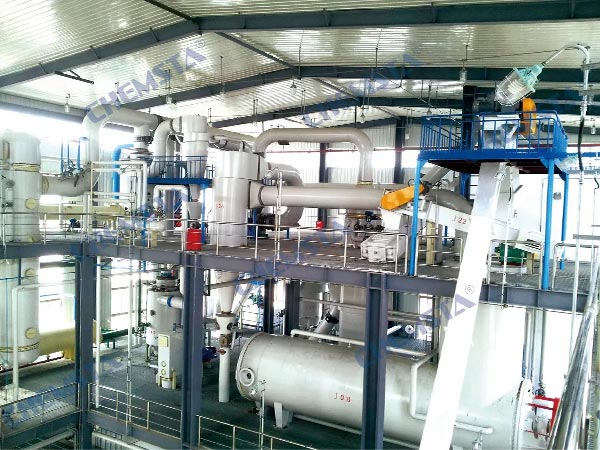
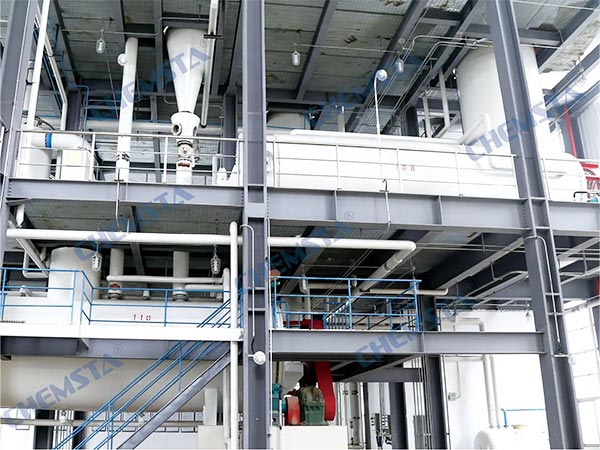
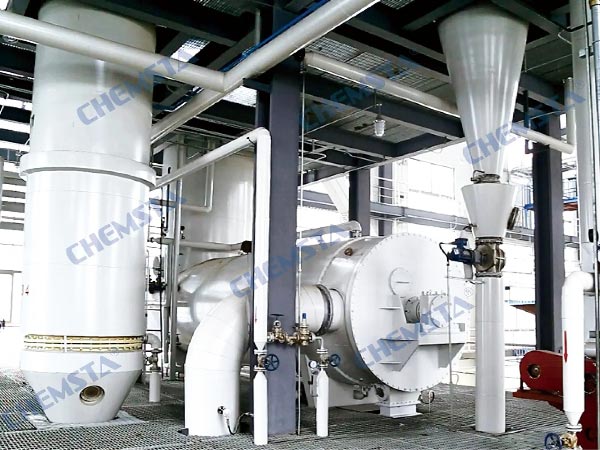
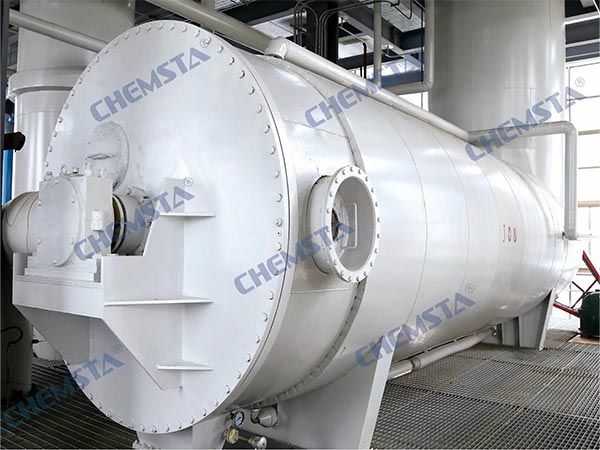
3. Oil Filtration:
Oil Filtration is designed to filter out solid impurities prior to miscella evaporation. Devices used in this process include a high pressure delivery pump, centrifugal separator, and a filter with a slagging function. The optimum filtration effect is achieved by a combination of centrifugal separation precise filtration processes. Because the filter is able to automatically remove slag, no manual operation is needed.
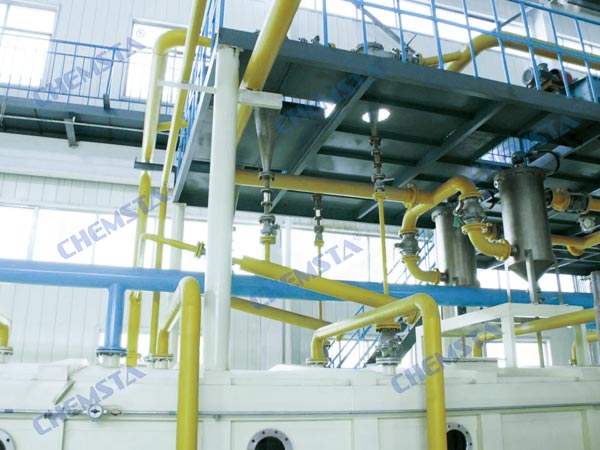
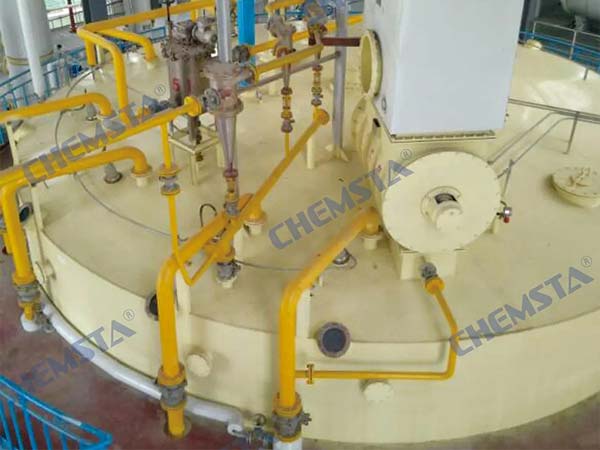
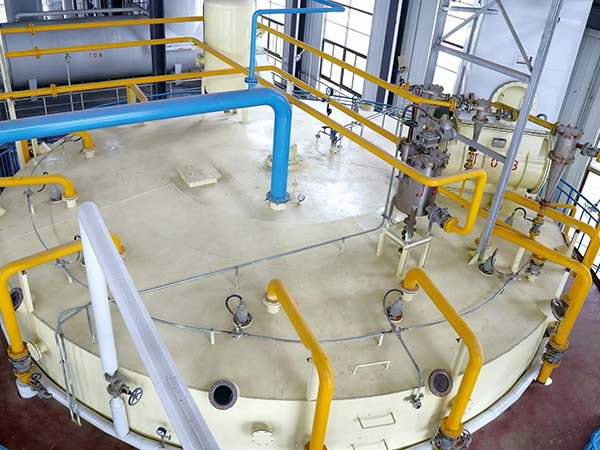
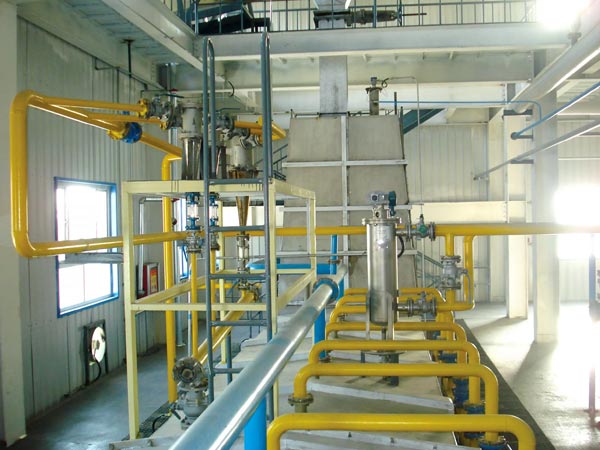
4. Evaporation System:
Equipment in evaporation system involves evaporator, disc stripping tower, flash separator, heat exchanger, and vacuum unit. Under vacuum and negative pressure condition, solvent in the miscella will be evaporated and separated by rising film evaporation and direct stripping process. After desolvation, bright color leached oil will be obtained. To ensure the system stability and reliability, an automatic PLC control system is used to control the evaporating temperature and vacuum level. Both mixed steam and power steam for the vacuum pump will be used for evaporation. Heat transfer and mass transfer between the cool and hot medium furthers reduces steam consumption, In addition, lipid oxidation can be prevented as well.
The purified miscella is controlled by the flow rate, it enters the first evaporation system, and the secondary steam of low temperature desolventizer (Tank A) and the jet pump residual vapor of the negative pressure condenser are used as a steaming heating medium. The evaporated solvent is passed through a separator into a vacuum condenser. The use of full negative pressure evaporation can reduce the boiling point of the miscella and improve the heat utilization rate. The concentration of the miscella after the first evaporation and concentration can reach 75%, the miscella flows from the first evaporator to the second evaporator, and the shell side of the second evaporator is heated by the indirect steam. The steam consumption of the second evaporator is very low, so that the concentration of the miscellal reaches 95%, the outlet miscella is pumped into the stripper by the pump. The miscella falls into the stripper from the top and gradually decreases. At the same time, the bottom is sprayed with direct steam to remove the residual solvent in the oil. At the top outlet, mixed steam connected to a vacuum condenser, the condenser is connected to the jet pump to keep the stripper operating under a certain negative pressure. A liquid level indicator is installed at the bottom of the stripper to ensure a stable liquid seal and oil flow.
The purified miscella is controlled by the flow rate, it enters the first evaporation system, and the secondary steam of low temperature desolventizer (Tank A) and the jet pump residual vapor of the negative pressure condenser are used as a steaming heating medium. The evaporated solvent is passed through a separator into a vacuum condenser. The use of full negative pressure evaporation can reduce the boiling point of the miscella and improve the heat utilization rate. The concentration of the miscella after the first evaporation and concentration can reach 75%, the miscella flows from the first evaporator to the second evaporator, and the shell side of the second evaporator is heated by the indirect steam. The steam consumption of the second evaporator is very low, so that the concentration of the miscellal reaches 95%, the outlet miscella is pumped into the stripper by the pump. The miscella falls into the stripper from the top and gradually decreases. At the same time, the bottom is sprayed with direct steam to remove the residual solvent in the oil. At the top outlet, mixed steam connected to a vacuum condenser, the condenser is connected to the jet pump to keep the stripper operating under a certain negative pressure. A liquid level indicator is installed at the bottom of the stripper to ensure a stable liquid seal and oil flow.
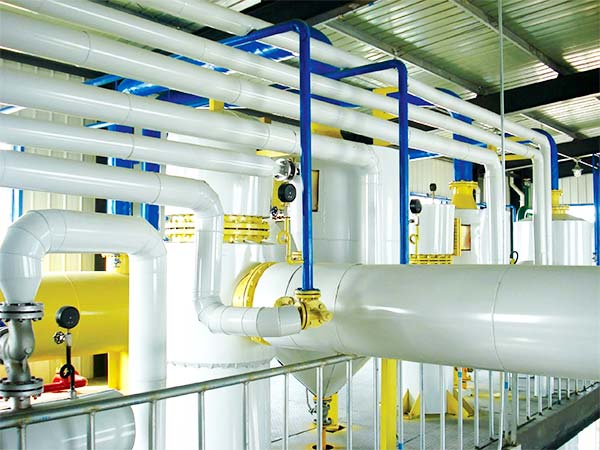
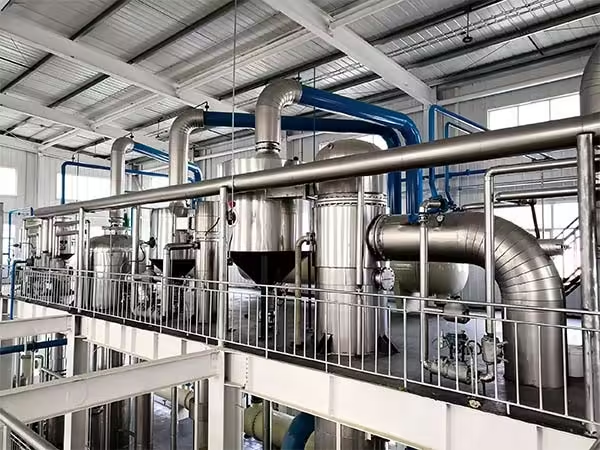
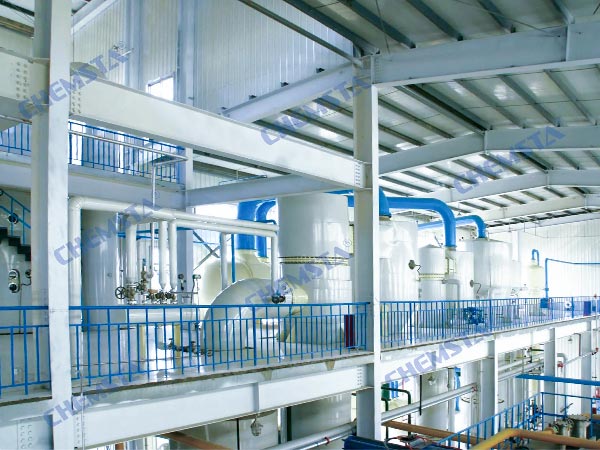
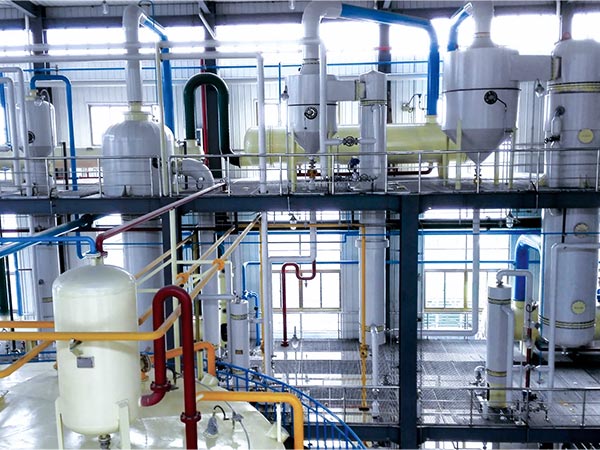
5. Solvent Condensation and Recovery System:
Solvent condensation and recovery system consists of condenser and cool water system. Under vacuum and negative pressure conditions, the condensable solvent steam is condensed into liquids for cyclic utilization through a dividing-wall heat transfer. Multiple pass structure of the condenser and proper settings of flow rate and speed of circulating water will greatly improve efficiency of the condensation and separation, while also reducing investment capital and operating costs. In addition, tube plates, baffle plates, and heat exchange tubes are all made of stainless steel S30408, which facilitates cleaning and withstands corrosion . Moreover, great condensation effect and long service life can be fully ensured.
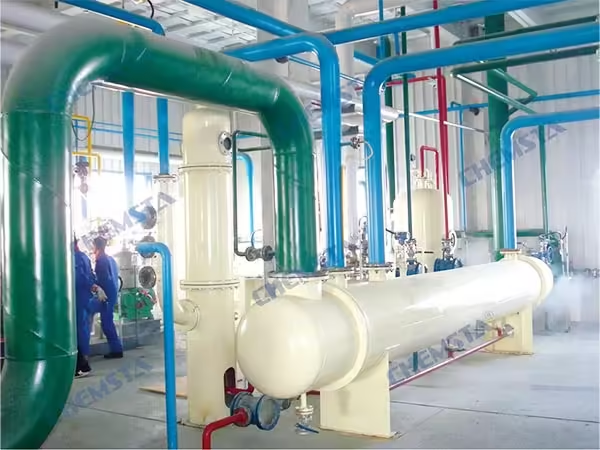
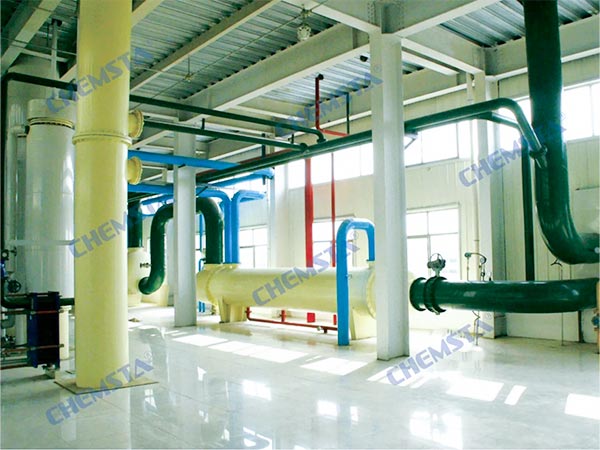
6. Paraffin Absorption System:
Paraffin absorption system consists of paraffin absorption column, paraffin desorption column, heat exchanger, storage tank, circulating pump, explosion-proof fan and fire protector. This absorption system is able to recycle more than 98% of solvent in the exhaust gas, which reduces the solvent gas loss and protects the environment. The system makes use of food-grade liquid paraffin to adsorb the solvent gas mixed in exhaust gas. Solvent steam is distilled and separated with the help of superheated steam, and the solvent steam obtained through this process will be recycled through condensation. To ensure stable absorption efficiency and system reliability, automatic controls are used to control important parameters such as flow rate, temperature and pressure.
All the free gas in the extraction workshop enters into the balance tower and the final exhaust gas condenser, and then enters into the absorption tower. The liquid paraffin is sprayed from the upper part of the absorption tower, and absorbs the paraffin oil of the solvent contained in the exhaust gas, which is called rich oil and flows into the bottom of the tower. The absorbed exhaust gas is discharged from the top of the absorption tower through the flame arrester into the atmosphere.
The rich oil is pumped into the heat exchanger by the pump, exchanges heat with the paraffin oil that is not absorbing the solvent (lean oil), and then heated to a certain temperature by the rich oil heater to enter the top of the desorption tower. Countercurrent contact with the direct steam at the bottom, the absorbed solvent is removed, and the solvent mixed gas evaporated from the desorption tower enters into the vacuum condenser for recovery.
All the free gas in the extraction workshop enters into the balance tower and the final exhaust gas condenser, and then enters into the absorption tower. The liquid paraffin is sprayed from the upper part of the absorption tower, and absorbs the paraffin oil of the solvent contained in the exhaust gas, which is called rich oil and flows into the bottom of the tower. The absorbed exhaust gas is discharged from the top of the absorption tower through the flame arrester into the atmosphere.
The rich oil is pumped into the heat exchanger by the pump, exchanges heat with the paraffin oil that is not absorbing the solvent (lean oil), and then heated to a certain temperature by the rich oil heater to enter the top of the desorption tower. Countercurrent contact with the direct steam at the bottom, the absorbed solvent is removed, and the solvent mixed gas evaporated from the desorption tower enters into the vacuum condenser for recovery.
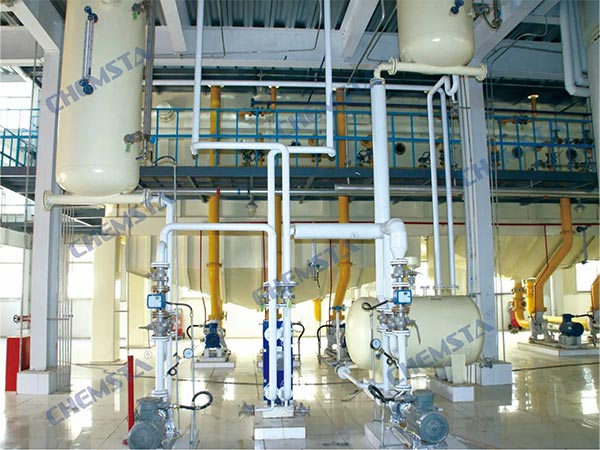
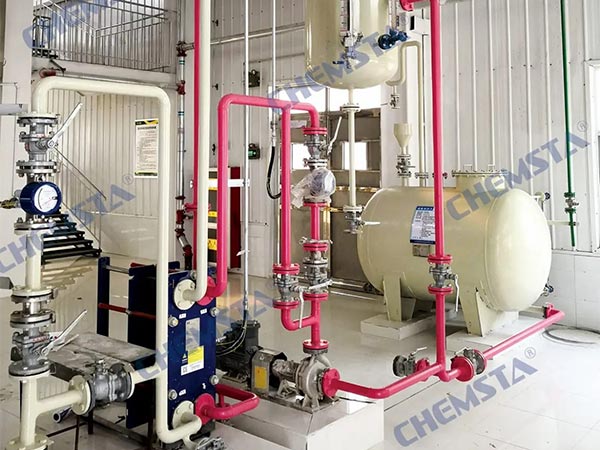
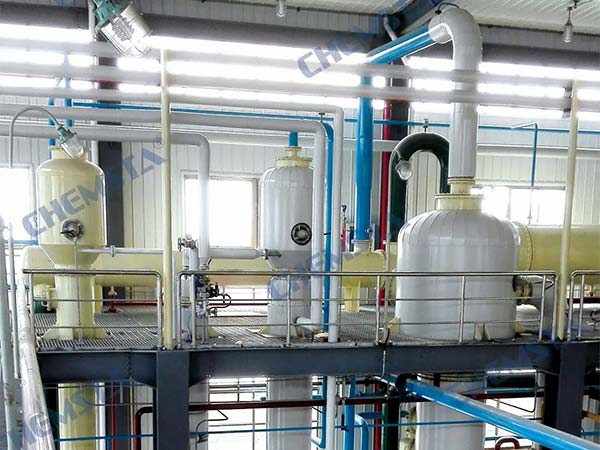
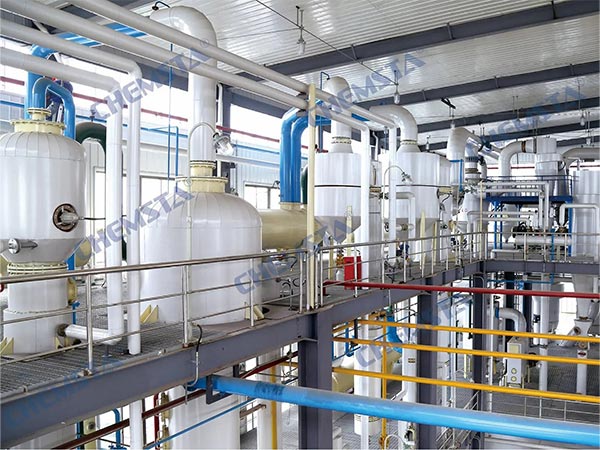
7. Water & Solvent Separation Section:
This system consists of solvent-water separator, boiling tank,and fresh solvent pump. It separates water from solvent based on the principle that water repels solvent and two liquid layers will be formed in their mixture. To ensure stability and reliability of the system, automatic control devices are applied to control important parameters such as flow rate, temperature and material level.
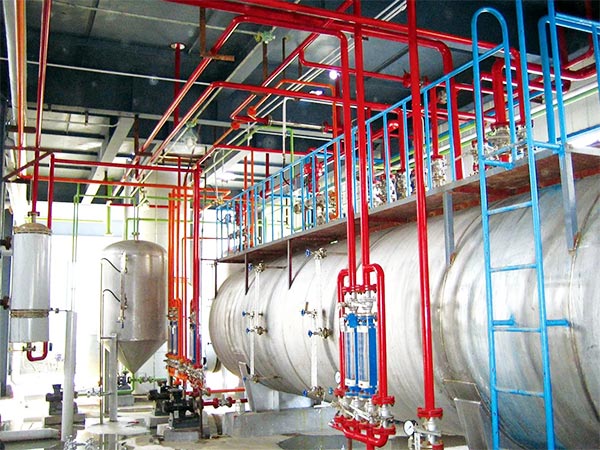
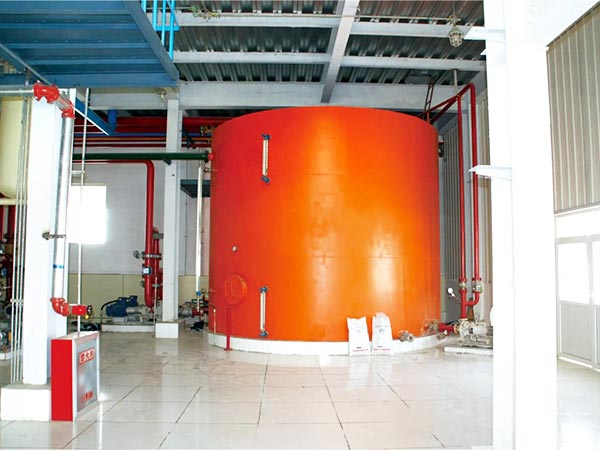
Automatic Control System
In CHEMSTA production lines, we make use of Siemens PLC control system, which is one of mainstream automatic control systems in today`s industry. The efficient, stable and advanced DCS control system consists of operation station, control station and communication network. We utilize high-speed and large-capacity S7-400 series PLC at the control system, large-screen LCD at the operation station, WINCC 7.0 industrial control software as monitoring software and PROFIBUS filed bus network for communication.
